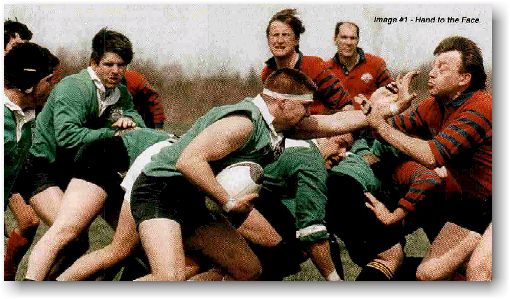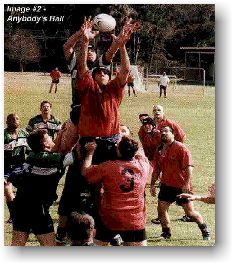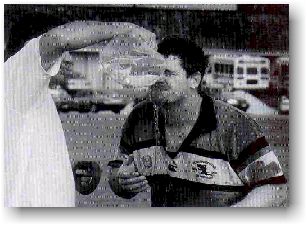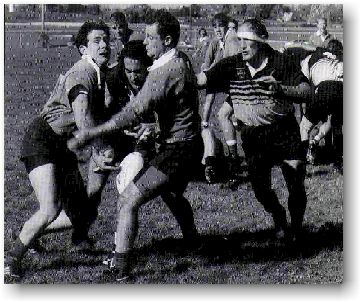Photographing Rugby
By Gerald Griffin, Hilton Head,
South Carolina
(PSA Journal, November 2002)
During my early years of photographing sports for photojournalism
competitions, I discovered one that offered me the opportunity to take some
wonderful images. I had not played it and even didn't know the rules! But rugby
has become a staple in my own photography, although not without a great deal of
learning.
The Game
The game of Rugby began at
the Rugby School in England in 1823. Two teams of fifteen players each play the
game. The field or pitch is about 110 by 75 yards. There are two halves of 40
minutes with a 5-minute halftime. During play any player may carry the ball,
kick it, pass it backwards or score. Players are not permitted to pass the ball
forward, block or even touch an opponent without the ball. There is one
referee, "the sole judge of fact and law" and two touch or sideline
judges. Five points are given for a "try" (similar to a touchdown)
where the player gets the ball into the opponent's end zone and touches the
ball to the ground. After a try, two points may be awarded for a successful
place kick or drop kick through the goalposts. Drop kicks and penalty kicks
(each worth three points) are also ways to score. During play there are rucks,
mauls, scrums and lineouts. Each of these with its own set of rules.
More people enjoy rugby than
you might think. While not widely known in the U.S., it is a game for all kinds
of people. You can find amateur men's leagues, girl's rugby, college rugby
...and even senior's rugby. All of my work has been with amateur teams in the
Rochester, N.Y. or Hilton Head, S.C. areas.
The local newspaper sports
department is often a good starting point to find out if there are teams in
your area. The Internet is also a great source of information. Try going to one
of the Internet search engines (like Yahoo!) and typing "rugby."
There is a wealth of useful information available there. Local colleges may
have teams. Most amateur games are on the weekends.
In Savannah, GA there is a
two-day St. Patrick's Day tournament run by the Savannah Shamrocks rugby team.
Eight games go on at once, all day long. Teams from as far away as Maine come
to play.
Like all sports photography,
the best images of rugby contain:
(1) Peak action -- an image
where the action has reached a "climatic" moment.
(2) The ball. Seeing the ball
in the image is essential. Otherwise it just looks like someone getting mugged!
(3) Facial expressions.
Player's faces with grimaces, smiles...faces that show anger, fear, joy...faces
that are dirty and sweaty. These are the makings of great and dramatic shots.
(4) Great colors. Uniforms
feature wonderful reds, greens and even the occasional harlequin pattern.
My Approach
 I
have two primary camera bodies, a Nikon 6006 and a Nikon 8008. Both allow me to
shoot continuously with the motor drive set on high, on low or sometimes shoot
single images. My best results have come with the low continuous setting. After
much trial and error, I only use one lens, my 70-200mm zoom. The results from
the times when I used a fixed 400mm lens just didn't give me images that I
liked. The players move across a wide area, and only a zoom can offer you the
flexibility to adapt to that difference in distance. If you are too far from
the action, the players appear too small in the image. Too close to the action
and you can lose the sense of the game. A zoom lens that goes to 300mm is
ideal.
I
have two primary camera bodies, a Nikon 6006 and a Nikon 8008. Both allow me to
shoot continuously with the motor drive set on high, on low or sometimes shoot
single images. My best results have come with the low continuous setting. After
much trial and error, I only use one lens, my 70-200mm zoom. The results from
the times when I used a fixed 400mm lens just didn't give me images that I
liked. The players move across a wide area, and only a zoom can offer you the
flexibility to adapt to that difference in distance. If you are too far from
the action, the players appear too small in the image. Too close to the action
and you can lose the sense of the game. A zoom lens that goes to 300mm is
ideal.
After a lot of experimenting
with film choices over the years, I use 400 speed Kodak Royal Gold or 800 speed
Kodak Max films for prints. I enlarge these to 16- by 20-inch prints and
haven't had a problem with grain size with either film. For slides I use Kodak
Elite Chrome 100 or preferably 200.
One thing is certain. The
speedier the film the greater your chance of capturing the action! Leave the
tripod and monopod at home. Having tried both, believe me, they will limit your
chances rather than help. Both are cumbersome and prevent you from moving
quickly up and down the sideline.
Shutter speeds are a matter
of taste. If you like some blur in your action you might like shooting at 1/60.
However, my experience is the faster the better. Shutter speeds of 1/125 or
faster will stop the action, and you'll be more likely to get facial expressions.
 Taking the Shots
Taking the Shots
At a typical amateur game you
may find a crowd of about 50 people. Most of these will be friends, significant
others, injured players and folks who may have played the game earlier in life.
It's actually quite a genteel crowd as sporting events go. If you are at an
amateur game you can position yourself on the sidelines. This is a double-edged
sword. You will be closer to the action, but you can also get "in harm's
way." The ball and players can come hurtling towards you and nimbleness is
a necessity. It's usually less crowded on the visitor's side of the field.
There are far fewer people there, and you won't have to dodge as many
spectators and game officials.
As with any other sport, one
of the keys to photographing rugby is capturing the ball. I have some great
action images with wonderful expressions, but no ball! The essence of the game
is lost. Experience has taught me to follow focus on the ball. Newer cameras
with faster auto focus are good. After you have watched and learned the game a
bit, you can start to anticipate the action and see potential for images before
they happen. One key advantage that rugby has over a sport like football is
that you can get some great facial expressions.
Image #1 (Hand to the Face)
shows a player carrying the ball and extending his arm to stiff-arm his
opponent. The opponent has anticipated the fact he's going to be hit and has
started to squint.
 I
can't stress enough that you have to watch the action out of both eyes: one
through the viewfinder on the action and the other watching to see that some
220-pound player doesn't knock you over. The best positions I have found are
usually at a 45-degree angle to the action. Other good spots are straight on
when there is a ruck (This is when 6-7 players from each side bend over and
push at each other while one player tosses the ball at their feet so it can be
kicked backwards and out of the melee).
I
can't stress enough that you have to watch the action out of both eyes: one
through the viewfinder on the action and the other watching to see that some
220-pound player doesn't knock you over. The best positions I have found are
usually at a 45-degree angle to the action. Other good spots are straight on
when there is a ruck (This is when 6-7 players from each side bend over and
push at each other while one player tosses the ball at their feet so it can be
kicked backwards and out of the melee).
Line tosses are another sequence that offers a good chance of
dramatic shots. Here the players line up opposite each other and one side
tosses the ball in between the lines. Players are lifted up by their teammates
to catch the ball high up as in Image #2 - Anybody's Ball.
Be careful to watch where you
are in relation to the sun. I have taken some good images with excellent action
only to find the faces in shadow. Now I am more careful to position myself so
the sun will be on the players' faces. This isn't always possible but I tend to
try that even if it means I give up my position on the visitor's side of the
field and go to the home side.
Since amateur rugby is often
played at places like high school fields, there is usually some distracting
background like a building in the far ground. It's the last thing I try to work
around, but be prepared for a cluttered background. Image #4, Squeezed, shows a
less than ideal background but the action, facial expressions and lighting are
what gives the image impact. Some teams are right-handed teams; e.g., they will
mostly run towards their right side. The first half of the game will give you
an idea of tendencies. However, the Hilton Head team I've shot seems always to
run plays towards their bench. So you never know for sure.
 Now
some final, but crucial words of advice: Stay off the field! In your zeal for
that great shot, do not be tempted to run out while the game is going on. I
know that sounds silly, but we photographers can do some crazy things to get
that one perfect shot. Still when there's a timeout I have snuck out a little
ways when I saw a shot. Image #3, Broken Nose Remedy, was such an occasion. One
fact about amateur rugby -- if you twist an ankle, break a nose, or get your
bell wrung, there is one universal treatment. They pour water on the offending
area. In this shot the played has broken his nose and so they are pouring water
on his head, which has accentuated the flow of blood.
Now
some final, but crucial words of advice: Stay off the field! In your zeal for
that great shot, do not be tempted to run out while the game is going on. I
know that sounds silly, but we photographers can do some crazy things to get
that one perfect shot. Still when there's a timeout I have snuck out a little
ways when I saw a shot. Image #3, Broken Nose Remedy, was such an occasion. One
fact about amateur rugby -- if you twist an ankle, break a nose, or get your
bell wrung, there is one universal treatment. They pour water on the offending
area. In this shot the played has broken his nose and so they are pouring water
on his head, which has accentuated the flow of blood.
Afterwards, be prepared to
throw away lots of pictures. I average maybe two useful images in a roll of 36 exposures.
The action is so fast that you'll get blurs, people on the sidelines
inadvertently getting in your way, players on the field in your line of sight,
wonderful action but no ball and images that are tilted as you rush to shoot.
Amateur rugby players are a
breed apart. But they are no different from everyone else in this way -- they
really appreciate getting pictures. So take a set to the next game or send them
to the coach. The team will really appreciate it. I made some 16- by 20-inch
enlargements of the Rochester Aardvarks amateur team for their clubhouse and
next thing I knew they gave me an Aardvark jersey. If this happens to you, I
recommend two things: first, thank them, and second, NEVER wear it to the game.
Otherwise you will find yourself inserted into the lineup and will wake up in
the hospital.